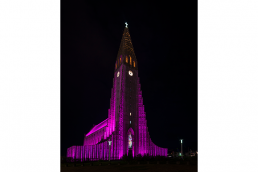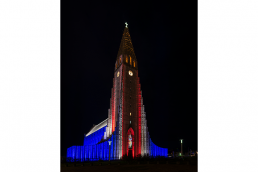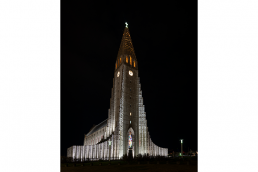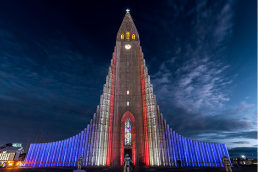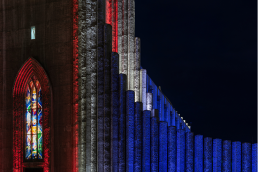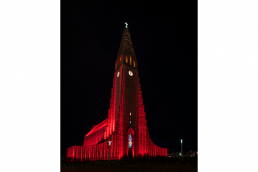This website uses cookies so that we can provide you with the best user experience possible. Cookie information is stored in your browser and performs functions such as recognising you when you return to our website and helping our team to understand which sections of the website you find most interesting and useful.
Hallgrímskirkja
ProjectHallgrímskirkjaLocationReykjavik, IcelandLighting DesignerLISKA, IcelandSubmitted byPharos Architectural Controls
The aim of the project was to redesign and improve the cathedral’s outdated and inadequate external lighting which had reached the end of its useful lifetime.
Only the front of the building was lit and had limited functionality, meaning a new, state-of-art flexible lighting system was required, with dynamic controls and smart features. LISKA was appointed as the lighting designer to deliver the scheme, with a brief to ensure the new LED fixtures were as hidden as possible, and interventions to the building’s structure were minimal.
This was delivered through a number of partnerships, including the selection of Pharos Architectural Controls to realise the lighting control requirements.
Hallgrímskirkja is a world-famous landmark in Iceland’s capital, Reykjavik. Visible from almost anywhere in the city due to its 73-metre-high tower, the cathedral is instantly recognised by its striking façade of descending pillars. As well as a place of worship, Hallgrímskirkja also hosts cultural events and is a popular tourist destination, particularly for photo opportunities.
Pharos provided a multitude of solutions from its award-winning portfolio; specifically, two Pharos Designer LPC2s (Lighting Playback Controller), and one Pharos Designer TPS (Touch Panel Station).
The Pharos Designer LPC is an all-in-one control solution that is ideal for large-scale LED lighting installation, such as Hallgrímskirkja. As a rugged, compact unit, the Pharos Designer LPC is designed to offer complete reliability even when in 24/7 operation.
The Pharos Designer TPS is an elegant, touch-screen lighting controller with a customisable 4.3-inch capacitive touch panel that works with any Pharos Designer Controller. Together the LPCs and TPS enable automatically scheduled lighting scenes, dimming profiles and on-site manual control of the exterior lighting.
The design comprises exterior lighting that grazes the façade, roof and tower with colder tones, offsetting the warm lighting of the interior and clock tower. Carefully planned placement of the light fixtures with considered positioning has enhanced the three-dimensional surface and added contrast to the beautifully flowing texture of the façade. In addition, the luminaires are strategically located so they do not visually disrupt the architecture and surrounding public spaces. The added benefit is that their placement avoids any risk of glare to passers-by.
Hallgrímskirkja is a beautiful structure, that can be spotted from almost anywhere in Reykjavik. With an outdated lighting system, it was long overdue for an improvement that can deliver a whole range of benefits. The dynamic lighting effects and controllability that are now possible through the use of Pharos technology ensure this stunning cathedral can be admired even more for its spectacular
structure and what it brings to this Icelandic city’s skyline.
The updated lighting scheme at Hallgrímskirkja has truly enhanced the historical architecture, and successfully illuminates the church so that it is visible throughout the dark nights, and that the church is recognised as a focal place of worship in Reykjavik.
As well as providing light for general purposes, the external lighting is programmed to celebrate religious, national and international calendar events. This is through both static and dynamic lighting scenes. While these special scenes are programmed in advance to align with these calendar dates, the lighting can also be controlled directly via DMX using the Pharos Architectural Controls’ Designer
TPS.
The introduction of RGBW lighting has enhanced this, ensuring more visually pleasing effects that embrace colour to deliver an air of excitement and a new lease of life to the public space around the structure.
Hallgrímskirkja is known across the world for its striking façade and picturesque architecture. Creating a lighting scheme for such an iconic place of worship is an honour. The aim of the project was to enhance its existing beauty while also offering more, such as the ability to illuminate in colour and with a dynamic approach to support key events. Every time members of the public see Hallgrímskirkja in all of its beauty, they are reminded of the power of dynamic lighting to such an iconic building.
To aid sustainability, an automatic lighting cycle adjusts to the Nordic winter darkness, while saving energy through the brighter periods by applying dimming profiles. All of the exterior lights are then turned off during the night to reduce light pollution.
Overall, the new scheme has delivered huge advantages to Hallgrímskirkja, improving aesthetics, flexibility and control, and sustainability.
